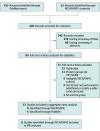Association of Very Preterm Birth or Very Low Birth Weight With Intelligence in Adulthood: An Individual Participant Data Meta-analysis
- PMID: 34047752
- PMCID: PMC8329745
- DOI: 10.1001/jamapediatrics.2021.1058
Association of Very Preterm Birth or Very Low Birth Weight With Intelligence in Adulthood: An Individual Participant Data Meta-analysis
Abstract
Importance: Birth before 32 weeks' gestation (very preterm [VPT]) and birth weight below 1500 g (very low birth weight [VLBW]) have been associated with lower cognitive performance in childhood. However, there are few investigations of the association of neonatal morbidities and maternal educational levels with the adult cognitive performance of individuals born VPT or VLBW (VPT/VLBW).
Objective: To assess differences in adult IQ between VPT/VLBW and term-born individuals and to examine the association of adult IQ with cohort factors, neonatal morbidities, and maternal educational level among VPT/VLBW participants.
Data sources: Systematic review of published data from PubMed and meta-analysis of individual participant data (IPD) of cohorts from 2 consortia (Research on European Children and Adults Born Preterm [RECAP] and Adults Born Preterm International Collaboration [APIC]).
Study selection: The meta-analysis included prospective longitudinal cohort studies that assessed the full-scale IQ of adults born VPT or VLBW and respective control groups comprising term-born adults.
Data extraction and synthesis: The study followed the Preferred Reporting Items for Systematic Reviews and Meta-analyses (PRISMA) reporting guideline for analyses of individual participant data and identified 8 studies that provided data from 2135 adults (1068 VPT/VLBW and 1067 term-born participants) born between 1978 and 1995. Meta-analyses of IPD were performed using a 1-stage approach, treating VPT birth or VLBW and cohort as random effects.
Main outcomes and measures: Full-scale IQ scores were converted to z scores within each cohort using the combined SD of VPT/VLBW participants and a control group of term-born participants, with scores centered on the mean of the control group.
Results: A total of 426 records were identified and screened. After exclusions, 13 studies were included in the aggregate meta-analysis. The IPD meta-analysis included 8 of the 9 RECAP and APIC cohorts with adult IQ data. The mean (SD) age among the 8 IPD cohorts was 24.6 (4.3) years, and 1163 participants (54.5%) were women. In unadjusted analyses, VPT/VLBW participants had mean adult IQ scores that were 0.78 SD (95% CI, -0.90 to -0.66 SD) lower than term-born participants, equivalent to a difference of 12 IQ points. Among VPT/VLBW participants, lower gestational age (score difference per week of gestation, 0.11; 95% CI, 0.07-0.14), lower birth weight z scores (score difference per 1.0 SD, 0.21; 95% CI, 0.14-0.28), the presence of neonatal bronchopulmonary dysplasia (score difference, -0.16; 95% CI, -0.30 to -0.02) or any grade of intraventricular hemorrhage (score difference, -0.19; 95% CI, -0.33 to -0.05), and lower maternal educational level (score difference, 0.26; 95% CI, 0.17-0.35) were all significantly associated with lower IQ scores in adulthood.
Conclusions and relevance: In this IPD meta-analysis, lower gestational age, lower weight for gestational age, neonatal morbidities, and lower maternal educational levels were all important risk factors associated with lower IQ among young adults born VPT or VLBW.
Conflict of interest statement
Figures


References
-
- Sternberg RJ. Intelligence. In: Holyoak KJ, Morrison RG, eds. The Cambridge Handbook of Thinking and Reasoning. Cambridge University Press; 2005:751-773.
-
- Hegelund ER, Flensborg-Madsen T, Dammeyer J, Mortensen EL. Low IQ as a predictor of unsuccessful educational and occupational achievement: a register-based study of 1,098,742 men in Denmark 1968–2016. Intelligence. 2018;71:46-53. doi:10.1016/j.intell.2018.10.002 - DOI
-
- Strenze T. Intelligence and socioeconomic success: a meta-analytic review of longitudinal research. Intelligence. 2007;35(5):401-426. doi:10.1016/j.intell.2006.09.004 - DOI
Publication types
MeSH terms
Grants and funding
LinkOut - more resources
Full Text Sources
Other Literature Sources

